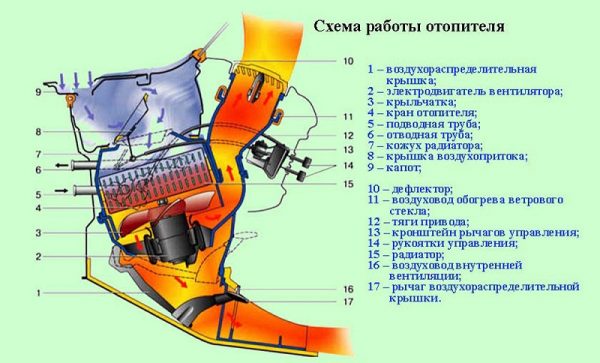
Self-repair, maintenance and tuning of the stove VAZ 2107
Content
The main function of the heating system of any car is to create and maintain a comfortable microclimate in the passenger compartment. In addition, the stove prevents the glass from fogging up and removes frost from them in the cold season. Therefore, keeping the heating system in working order is important for any car owner.
The device and principle of operation of the heating system VAZ 2107
The VAZ 2107 stove creates and maintains a comfortable air temperature in the cabin and prevents the glass from fogging in cold and wet weather. It consists of:
- heater;
- fan;
- control unit.
Outside air through a hole in the bonnet enters the air intake casing located in the engine compartment under the windshield. Then it goes to the heater, where most of the moisture contained in it condenses. However, until the radiator is fully warmed up, slightly humid air will enter the passenger compartment.
The stove radiator is heated by the coolant (coolant) coming from the cooling system. The temperature is regulated by a special tap, which partially blocks the flow of hot coolant going into the heating system. The more heated liquid enters the stove radiator, the warmer it will be in the car. The position of the crane is changed by the regulator from the passenger compartment by means of a flexible rod.
Air enters the passenger compartment using a heater fan, the rotation speed of which is regulated by a special resistor. When the vehicle is moving at high speed, the heating system can work without the fan turned on. The air flow under the hood creates increased pressure in the air intake box and pumps warm air into the passenger compartment.

The heated air is directed through the air duct system to different parts of the passenger compartment, as well as to the windshield and side windows, preventing them from fogging up in cold and wet weather.
The operation of the stove is controlled using several handles on the instrument panel. The upper handle regulates the position of the heater tap (leftmost position - the tap is completely closed, extreme right - fully open). With the help of the middle handle, the position of the air intake cover is changed. By turning it to the right and to the left, the intensity of the warm air supply increases and decreases accordingly. The lower handle adjusts the dampers of the windshield heating ducts. In the right position, the air flow is directed to the side windows, in the left position - to the windshield.
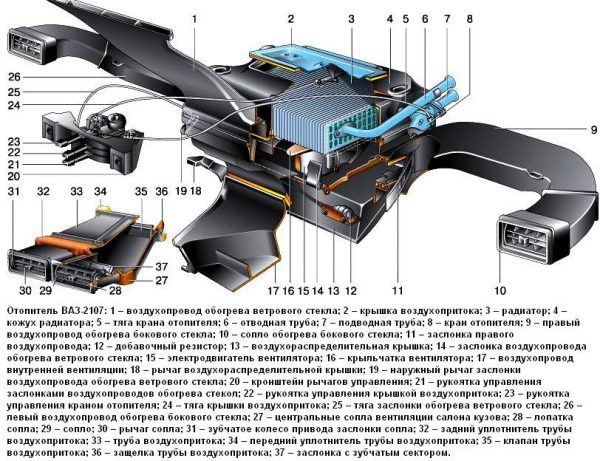
Learn how to replace a thermostat on a VAZ 2107: https://bumper.guru/klassicheskie-modeli-vaz/sistema-ohdazhdeniya/termostat-vaz-2107.html
Refinement of the heating system
The device of the VAZ 2107 stove is far from perfect. Therefore, car owners are finalizing it in a variety of ways. First of all, attempts are being made to improve the tightness of air ducts, especially at the joints. This allows you to slightly increase the efficiency of heating the passenger compartment.
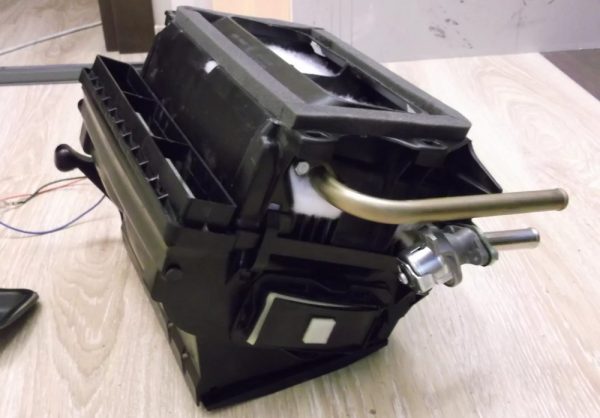
Fan replacement
Often, to improve the operation of the stove, motorists change their native fan to a more powerful one used in other VAZ models (for example, VAZ 2108). The factory fan motor is mounted on plastic bushings that wear out quickly. As a result, shaft play appears, and a whistle is heard in the cabin when the fan is running. Repair and lubrication of the bushings in this case, as a rule, does not bring the expected effect. The fan motor VAZ 2108 is mounted on bearings. Therefore, its installation in the VAZ 2107 stove will not only increase the efficiency of interior heating, but also make the fan more reliable.
Usually, along with the fan motor, a number of other elements of the stove control unit are also changed.. The rotational speed of the factory fan VAZ 2107 at a current of 4,5A is 3000 rpm. The VAZ 2108 electric motor consumes 4100A at a frequency of 14 rpm. Therefore, when replacing, you should install the appropriate fuse, resistor (usually from Niva) and a speed switch (for example, from Kalina).
Video: finalization of the VAZ 2107 stove
To dismantle the fan, you will need:
- flat and cross-head screwdrivers;
- keys for 7 and 10;
- round nose pliers.
The fan is removed in the following order.
- The instrument panel, shelf and glove box are dismantled.
- Using a 7 key, the cover of the air damper control cable is loosened. The cable loop is removed from the lever.
- Using a 10 key, unscrew the heater housing fastening nut.
- Using a flat screwdriver, the left and right air ducts are removed from the stove body.
- A flat screwdriver removes the latches that fix the fan on the stove.
- The wire terminals are disconnected.
- The fan is removed from the stove body.
- The impeller is removed. Round nose pliers are used if necessary.
The size of the new fan (from VAZ 2108) is slightly larger. Therefore, its installation will require some changes in the design of the stove. If only the motor changes, it will be necessary to make an additional hole in the grille through which warm air enters the lower part of the passenger compartment. If this is not done, the motor housing will rest against the grate.
Replacing the stove body
When installing a fan from a VAZ 2108, a new frame will be required, usually made of plexiglass. It is quite time consuming and requires certain skills.


When making a new frame, all dimensions must be strictly observed. The slightest inaccuracies can lead to vibration or failure of the new fan. After assembling the structure, grease the joints with sealant and install the new housing in place. After that, the noise level in the cabin usually decreases, and the stove begins to heat the air better.
The air intake should ALWAYS be from the street, especially in winter, otherwise the windows will sweat (and freeze in winter). Air intake from the passenger compartment is done only when the air conditioner is on (in the seven this question is not worth it).
The fact that it doesn’t blow into one “sleeve” is possible: a) when machinating with the stove, the sleeve didn’t get into the right place and the stove blows somewhere under the panel, b) some crap got into the nozzle (foam rubber or something like that ).
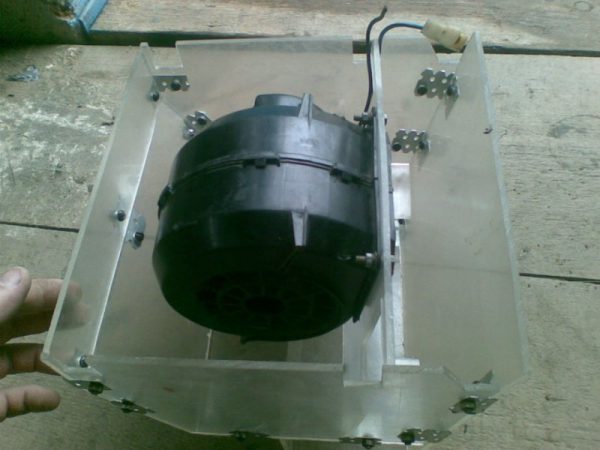

Other options for tuning the stove
Sometimes the design of air ducts is being finalized. Additional holes are made in the body of the stove into which plumbing hoses are inserted. Through these hoses, connected to the side and lower air ducts, when the engine is running, an additional flow of warm air is created on the windows and legs.
Often the cause of poor interior heating is clogging of the stove radiator. The coolant begins to circulate more slowly or completely ceases to circulate through the heating system, and the efficiency of air heating is noticeably reduced. Usually in these cases, the radiator is replaced with a new one.
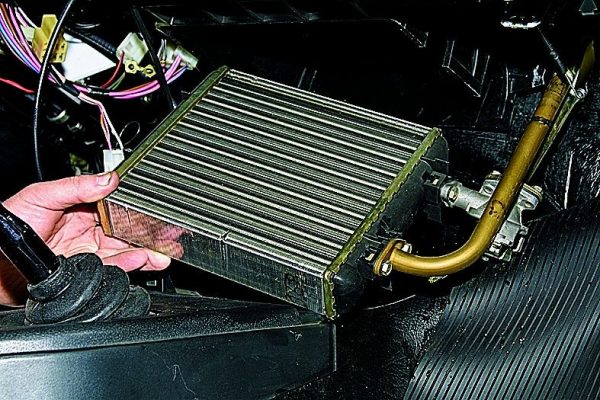

Basic malfunctions and ways to eliminate them
The most typical malfunctions of the VAZ 2107 stove include:
- Air entering the cooling system. This usually happens after the system has been filled with antifreeze. Eliminating the air lock normalizes the process of heating the cabin.
- When the heater tap is open, no coolant enters the radiator. Most often this happens when water is used as antifreeze. Scale builds up in the system, clogging the tap and making it difficult for the coolant to pass through. The problem is eliminated by dismantling the faucet and then cleaning or replacing it.
- Poorly functioning or failed water pump. If the pump does not pump coolant, this can lead not only to a lack of interior heating, but also to more serious problems, for example, engine overheating. The water pump does not work, as a rule, when the alternator belt breaks, as well as when jammed as a result of bearing wear.
- Clogged stove radiator cells. In this case, the supply pipe will be warm, and the outgoing pipe will be cold. The radiator is often clogged when water is used as a coolant, as well as when oil or particles of additives get into the system to eliminate leaks. Cleaning or replacing the radiator will help restore the normal operation of the stove.
- Displacement of the baffle in the radiator. If both radiator pipes are hot, and warm air does not enter the cabin, then most likely the partition in the radiator has shifted. The only solution to the problem is to replace the radiator with a new one.
More details about the VAZ 2107 pump: https://bumper.guru/klassicheskie-modeli-vaz/sistema-ohdazhdeniya/pompa-vaz-2107.html
If an oily coating appears on the floor or glass, you should look for an antifreeze leak, which may be:
- on tap;
- on pipes;
- on a radiator.
If a faucet or pipe is leaking, they should be replaced. A leaking radiator can be temporarily soldered, but it will still need to be replaced soon.
This list of possible malfunctions of the stove is not limited.
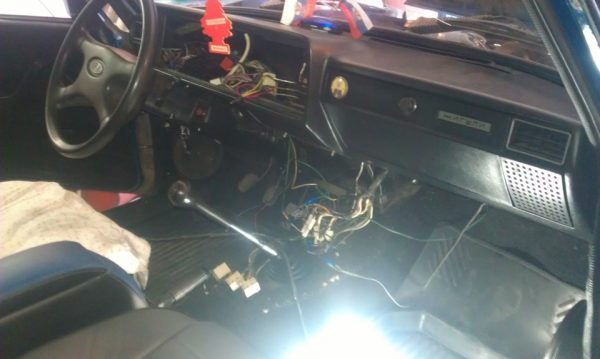

The stove does not turn off in the summer
Sometimes in the warm season, the stove cannot be turned off by setting the top handle of the control unit to the leftmost position. If it is not possible to close the tap, the tap itself or its drive cable is faulty. You can find the crane under the instrument panel on the passenger seat side. If manually closing it also fails, do not make great efforts. The tap may break, and the antifreeze may leak into the cabin.
You can replace the crane, having previously bought a new one, at any car service. However, you can try to do it yourself. It should be noted that changing the faucet with your own hands is quite inconvenient due to its location. First you need to open the hood and disconnect the pipe going to the tap. Since coolant will flow from the pipe, a previously prepared container must be placed under it. After that, you need to remove the storage shelf and from the passenger seat with a 10 key, unscrew the two nuts securing the crane to the stove body. Then the valve is removed from the studs, removed and replaced with a new valve in reverse order.
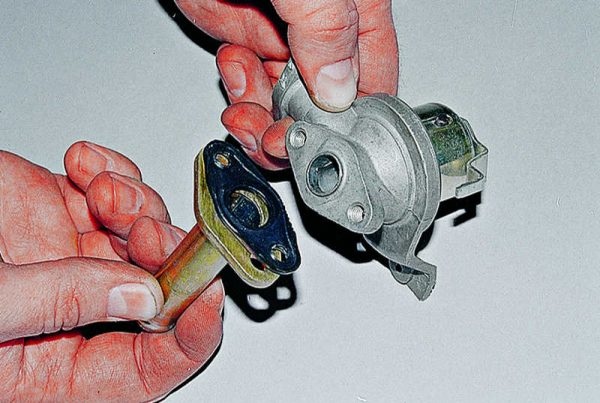

Clogged stove radiator
You can wash the clogged stove radiator yourself. This will require:
- two new rubber pads;
- two worm clamps;
- a set of keys;
- Coolant;
- container for collecting coolant.
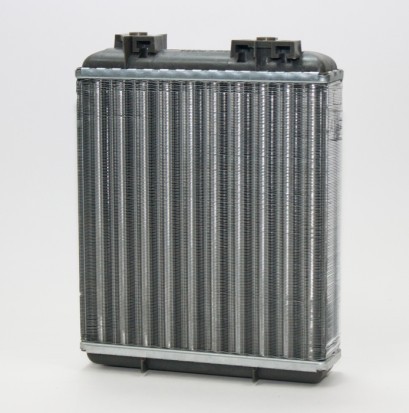

The radiator is flushed on a cold engine in the following sequence:
- There is a rag underneath the pipes that will be removed.
- The clamps for fastening the radiator pipes and the tap are loosened.
- The pipes are removed. The coolant from them is drained into a pre-prepared container.
- With a 7 key, the seal is removed from the partition of the engine compartment.
- The heater valve drive is disassembled.
- The fan cover is removed.
- The heater pipes are pulled out through the hole. The radiator is removed.
- With a 10 key, the bolts securing the radiator outlet pipe are unscrewed.
- The old gasket is replaced with a new one.
- The heater tap is disconnected and cleaned.
- The radiator is cleaned from the outside of leaves and dirt.
- The pipe is cleaned from the inside with a brush.
- The radiator is washed with Karcher under a pressure of 5,5 atm until clear water comes out of it. This will require about 160 liters of water.
- If there is no Karcher, caustic soda can be used for flushing. The soda solution is poured into the radiator and left for one hour. Then the solution is drained and its color is compared with the color of the fresh solution. The procedure is repeated until the color of the drained and filled liquids becomes the same.
- After washing with caustic soda, the radiator is purged with a compressor.
The radiator is installed in the reverse order. In this case, it is recommended to replace all clamps and gaskets with new ones.
The removed radiator can be disassembled by soldering its upper part and bottom with a gas burner, and cleaning its insides with a metal mesh mounted on a drill. In this case, you can use a special washing liquid, alkali or citric acid. Then the radiator is soldered and returned to its place. This procedure is quite time consuming, so it is often more expedient to replace the radiator with a new one.
Video: replacing the radiator of the VAZ 2107 stove


Watch this video on YouTube
Repair and replacement of individual elements of the heating system
In addition to the radiator, the heating system includes a fan with an electric motor, a faucet and a control unit.
Drivers who have been driving a Zhiguli for many years often say that the VAZ 2107 stove sometimes does not heat well. The most common cause of malfunctions in a system such as a VAZ 2107 stove is a radiator leak, as well as pipes, a faucet and connections located directly between them. To this can be added switch failures for electric fan modes, damage to the device wires or oxidation of their components.
Fan motor
The stove motor is considered one of the weakest points of the VAZ 2107. This is due to the material of the bushings on which the rotor rotates. When these bushings are worn out, the fan operation is accompanied by a characteristic whistle. This happens after two to three years of vehicle operation. The electric motor can be made operational by cleaning and lubricating. However, after a short time, the whistle from the side of the stove fan will appear again. In such cases, experts recommend replacing the standard electric motor with a new one - bearing. As a result, the whistle will disappear, and the reliability of the node will increase. The replacement process is associated with certain difficulties, since the electric motor is located in a rather inaccessible place. Nevertheless, after installation, the bearing motor is guaranteed to work for several years.
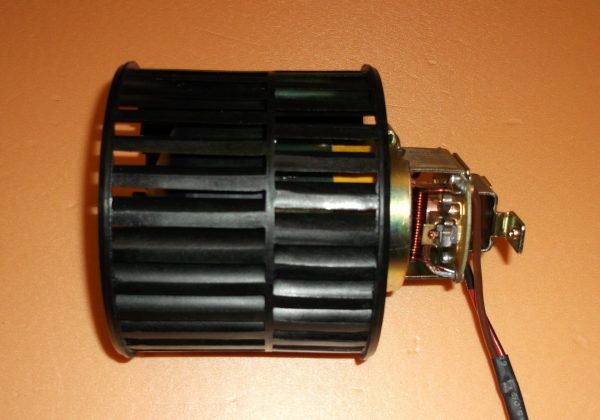

Read about the device of the radiator fan on the VAZ 2107: https://bumper.guru/klassicheskie-modeli-vaz/sistema-ohdazhdeniya/ne-vklyuchaetsya-ventilyator-ohlazhdeniya-vaz-2107-inzhektor.html
Heater tap
The heater valve is replaced when jammed, leaking, and in other cases when it cannot be repaired. Experts recommend in this case to install a ceramic faucet.
The heater's metal tap usually opens in the fall and closes in the spring. During periods of inactivity, it can turn sour, scale up and simply fail. The result can be extremely unpleasant for the car owner. These shortcomings are absent in a ceramic faucet. On ceramics, scale practically does not accumulate, and it is not subject to corrosion. As a result, even after a long downtime, the heater valve will be in working order.
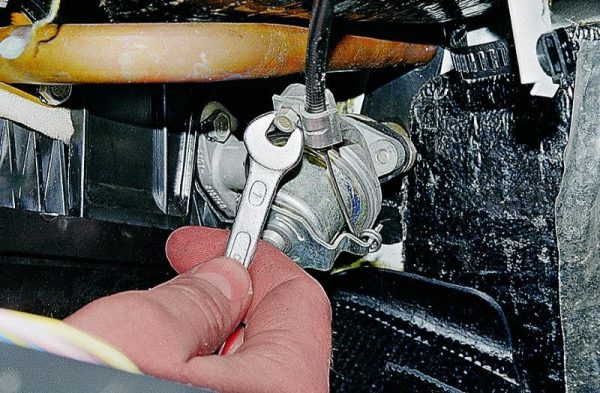

Блок управления
The heating system is controlled from the interior of the VAZ 2107 by several levers on the instrument panel, connected to the controlled elements by flexible traction (steel wire). With these levers you can:
- regulate the degree of opening of the air dampers;
- open and close the heater tap;
- distribute air flows between the windshield and side windows;
- take air from the engine compartment.
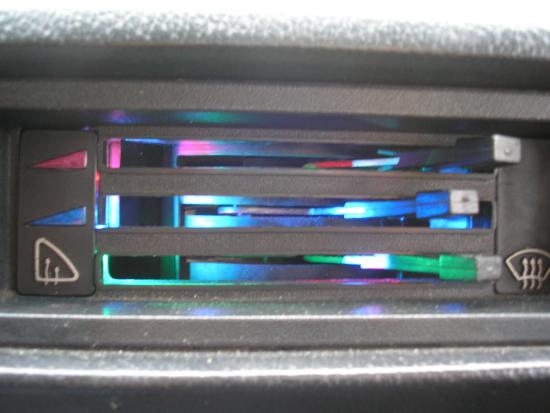

In addition, there is also a lower flap (air distribution cover), which is controlled by a special lever located under the dashboard on the driver's side.
Thus, any car owner can perform most of the repair, maintenance and replacement of elements of the VAZ 2107 heating system on their own. In addition, the recommendations of experts will help with their own hands to finalize the stove and make it work more efficiently.

